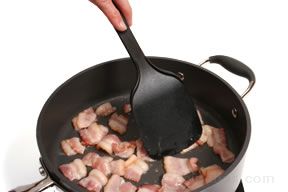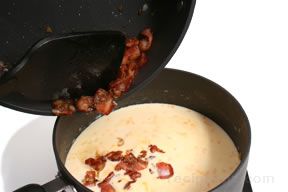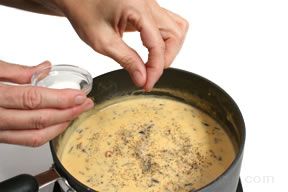Hot Liquid Cooking Techniques for Grain | Cooking Wild Rice
| The three basic techniques for cooking wild rice with hot liquid are boiling, absorption, and steaming, which are perhaps the most popular methods for cooking most whole grains. Often a combination of these methods is used to cook grain depending on the type of grain, the particular recipe, or the desired effect. Some grains benefit from soaking before they are cooked because cooking with hot liquid alone may not produce the optimum results. |
Hot Liquid Cooking Techniques for Grain
Boiling
Boiling is one of the easiest methods for cooking grain. The grain is cooked uncovered in a large quantity of water. The grain and water are then dumped into a colander and drained for several minutes to remove the excess moisture. This method is often the best when there is some doubt as to the correct quantity of water that can be absorbed by the grain.
|
Absorption
Cooking grain with the absorption method is, perhaps, the method that most people are accustomed to when cooking many types of grain, but it is often the most difficult. This technique requires that the grain be cooked in a specific quantity of liquid, which can be readily absorbed by the grain. The absorption method may require some trial and error, but it is most often successful when slight adjustments are made to recipes based on variables that may affect the success of the absorption cooking method, such as the accuracy of the heat source, the altitude, and age and quality of the grain.
|
Steaming
Steaming is the third method for cooking grain and although it is the most time consuming, it produces beautifully cooked grain. The grain slowly absorbs moisture and cooks very evenly.
Steaming alone usually is not adequate for cooking many types of grain, so it is often used in conjunction with other cooking methods and techniques. Some grains are boiled briefly before they are steamed while others may simply require soaking in cold water for a period of time to tenderize the grains prior to steaming. |
Cooking Wild Rice
|
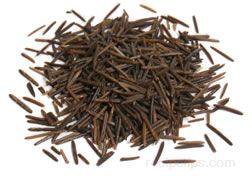
Wild rice usually requires more time to cook than regular rice. Undercooked wild rice has a hard texture and is difficult to chew. It often is beneficial to soak the grain for several hours or even overnight prior to cooking. Wild rice that is cooked perfectly consists of tender chewy grains that are butterflied, well rounded, and plump. Many people prefer wild rice grains that are only slightly split with a texture that is firm and chewy. The cooking time may vary widely depending on the texture desired and the type of wild rice that is used (wild rice that is lighter in color usually cooks in less time than darker varieties). Although wild rice may be expensive, it expands to three to four times its original size when it is cooked, so one pound of wild rice is enough to provide up to thirty-five servings.
Wild rice is served as a tasty side dish or it is often used as an ingredient for soups and casseroles. A small quantity added to steamed vegetables or tossed into salads provides flavor and texture, and it is one of the best accompaniments for poultry and fish.
Cooking Wild Rice with the Boiling Method |
| In a large saucepan, bring four cups of water to a boil. |
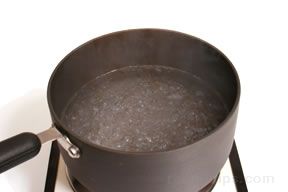 |
| Add one cup of wild rice, and return to a boil. |
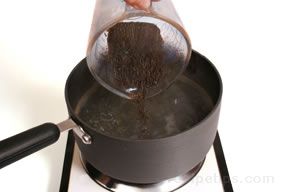 |
| Cover the pan, reduce the heat to low, and simmer the wild rice for about forty-five minutes. |
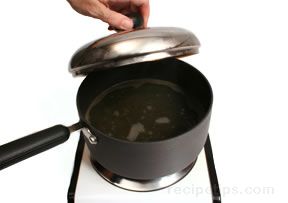 |
| Check the rice for doneness. If the rice is still too firm and chewy, simmer for an additional ten to fifteen minutes; then check the texture again. Grains that are only slightly split will be firm and chewy and grains that are fully butterflied will be tender. |
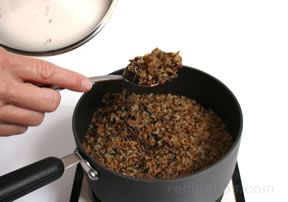 |
| The picture shows wild rice grains that have been cooked until slightly split—the texture is firm and chewy. |
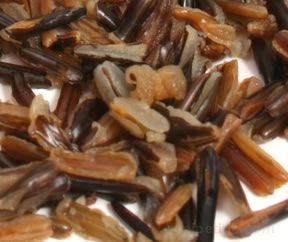 |
| The picture shows wild rice grains that have been cooked until fully butterflied—the texture is tender but still slightly chewy, or al dente. |
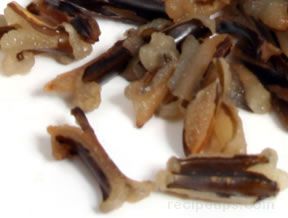 |
| When the rice has reached the desired texture, drain it, season it, and serve it. This recipe yields about three one-cup servings. |
 |
Using Wild Rice as an Ingredient for Soup
 Ingredients Ingredients
- 3 slices of bacon
- 4 tablespoons minced onion
- 10½-ounce can cream of potato soup
- 2 cups milk
- 8 oz. American cheese
- 1 cup cooked wild rice
- Salt and pepper
|
|









 Ingredients
Ingredients